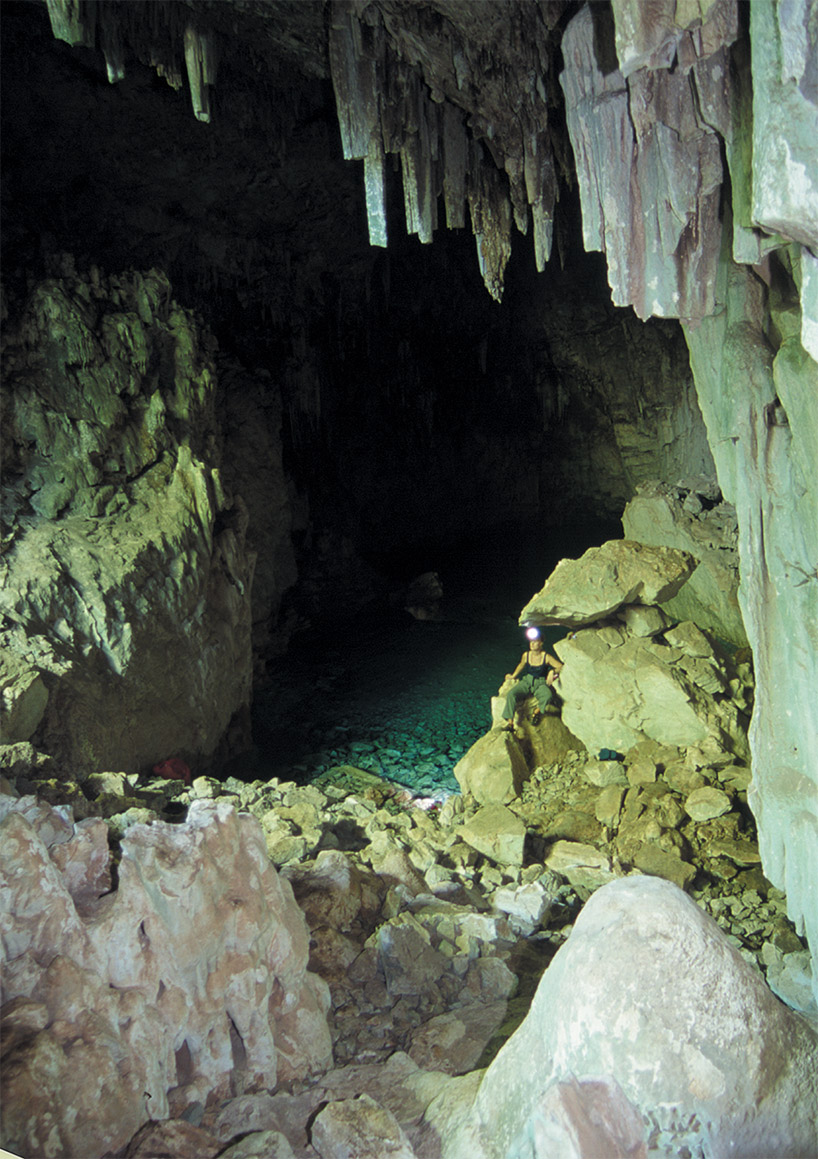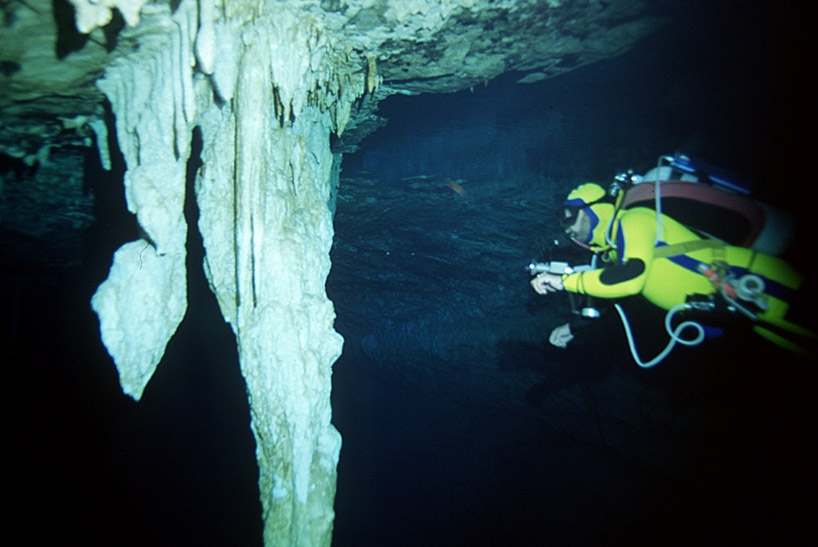

|
|
|
 |
Making my way down the steep rock pile towards the water's edge of Mimoso cave, my light drives back the darkness to reveal a coliseum filled with some of Mother Nature's finest works of art. Cobalt blue water fills the bottom of this immense room as the ceiling towers up into the darkness.
Slowly the dive team reaches the water's edge, toting bits and pieces of their dive and photography equipment. Several more trips by each diver and hired sherpas will be all that is needed before all of our equipment is in place.
It is refreshingly cool inside the cave as compared to the hot Brazilian sun, now beating upon our vehicles outside the cave entrance. |
|
| |
 |
| Located at a depth of 50 to 80 feet, these large calcite cones are unique to the caves in the Bonito area. Formed over millions of years, some of these cones reach heights of over 50 feet tall and several meters wide at their base. Explorer Jeff Bozanic assists in illuminating the Cone Room with a ikelite 400 watt slave strobe. |
|
|
| |
Gearing up, we slip shoulder deep into the gin clear water (75 degrees) for a quick dive briefing and equipment check. Crossing over a small sand hump, we drop below the water's surface and into an immense tunnel filled with bone white walls and impressive flow stones reaching down from the ceiling. The cave line directs us to the place we have traveled such a distance to see. We turn to the left and descend a sloping bank. Giant pillars of white rock appear into view. These pillars were formed during dry periods. The calcite dissolves from the marble ceilings and drips just one drop at a time, taking millenniums for the pillars to form. These sculptures of Mother Nature tower over 30 to 50 feet high from their base and can be over 10 feet in diameter. No where else in the world do these formations exist underwater, making these southern Brazilian caves unique and a must see by serious cave explorers.
Exploring the rest of Mimoso cave reveals several dry chambers farther back in the system. When visiting these dry air chambers, it is important to continue to breathe the gas from your cylinders since the oxygen content is dangerously low and could cause a working cave diver to pass out. |
|
| |
 |
| Artist 3-D's rendition of the Memoso cave system. Points of interest include the large cavern zone, impressive flowstone formations, the large Cone Room, and the Hypoxic room, where the oxygen levels are at dangerously decreased levels. When visiting these dry chambers it is important that the diver always continue to breath from his/her dive cylinders. |
|
|
| |
 |
| Large cavern zone in Memoso cave creates a challenging obstacle to transporting equipment to the water's surface. Multiple slave strobes are used to illuminate the extremely large cave, creating this unique image. |
|
|
| |
Abysmo An Humas: (below map)
Located high in the hills, this giant pit drops through a small crack on the surface to over 230 feet to the water's surface. A local company provides ropes, harnesses, and climbing ascenders for the drop into the pit and more importantly, the exit out.
Hooking onto the dynamic rope, the diver will slide 20 feet down through some tight restriction and through the cave's ceiling. The immense room opens up leaving the diver hanging in open space, 200 feet from the water. A small wooden dock has been constructed for a divers base and tenders busy themselves with lowering and raising dive equipment. Once having reached the dock, it is possible to climb up onto a rock ledge to work on your camera or video equipment.
The water in this cave is several degrees cooler (65 degrees) than the surrounding systems. Sloping from the left wall down to the right, the room's floor is covered with giant calcite cones. Several skeletons of unfortunate animals can be found on the cave floor after they had obviously fallen into the pit. Ducking under the right wall of the cave, the bottom drops into a giant crevasse. This pit's depth has been recorded to over 260 feet and still descending.
After the dive and a short rest, the equipment is hauled to the surface, then it's time for the long 30 minute plus self climb with the use ascenders to exit the cave. It's a good idea, to practice climbing skills prior to this dive. |
|
| |
 |
Above: Cutaway view of the Abismo An Humas cave system. A 230 ft. repel from the entrance to the waters surface is required to gain access.
Right: Diver Jeff Bozanic, assisted by sherpas gears up for an exploration dive into Abismo.
|
|
|
| |
Ceita Core: (not shown)
A small crystal clear spring flows into a pond located on a beautiful Brazilian cattle ranch. A 4-foot diameter entrance drops into a small room, where hundreds of catfish and small colorful fish hide in the shadows. At 15 feet, a restricted tunnel, just large enough to squeeze through with doubles, goes down for 30 feet until it opens on the top of a giant fisher crack. The crack is narrow, normally 3 to 15-feet but very wide, 50 to over 100 feet. The pit drops straight down to 265 feet then separates into two tunnels that bypass a breakdown pile. At a depth of over 350 feet, the two tunnels join back together. The visibility in this system is always over 100 feet and there is a nice blue mineral color to the water. To date, this cave has been explored by a Brazilian deep cave explorer to almost 500 feet deep, where it is said to clamp down too tight for any further exploration |
|
| |
 |
Above: Gustavo Sallum & Larry Cohen gear up for a dive into Formoso cave system which is known for attracting thousands of tropical butterflies.
Map: High flow cave map of Formoso and Formosinho |
|
|
| |
Formoso and Formosinho:
Different than the other local systems, Formoso Cave resembles more like a typical North Florida high-flow cave. While rigging up equipment the diver will be pleasantly tormented by thousands of multicolored butterflies, which visit this spring daily. Formoso's water visibility (20 to 100 ft.) is directly affected by the amount of local rainfall. The cave passage is typically 10'x10', with an occasional slight restriction. The walls are dark gray in color with sharp rocky edges, great for pull and glide techniques. A permanent line follows the main tunnel, with few off shooting gaps. swimming less than 20 minutes into the cave, it quickly gets deep as it twists and turns. Coming to a major junction at a penetration of 793 feet from the Formoso entrance, the main passage from spring Formosinho entrance joins in. Turning to the left, the main tunnel enlarges and quickly drops to an explored depth of over 280 feet.
The Bonito area offers other interesting sites to visit, such as beautiful waterfalls, crystal clear rivers, and an array of unique wildlife to the region. |
|
| |
 |
| |
| |
| |
| |
|
|
| |
|